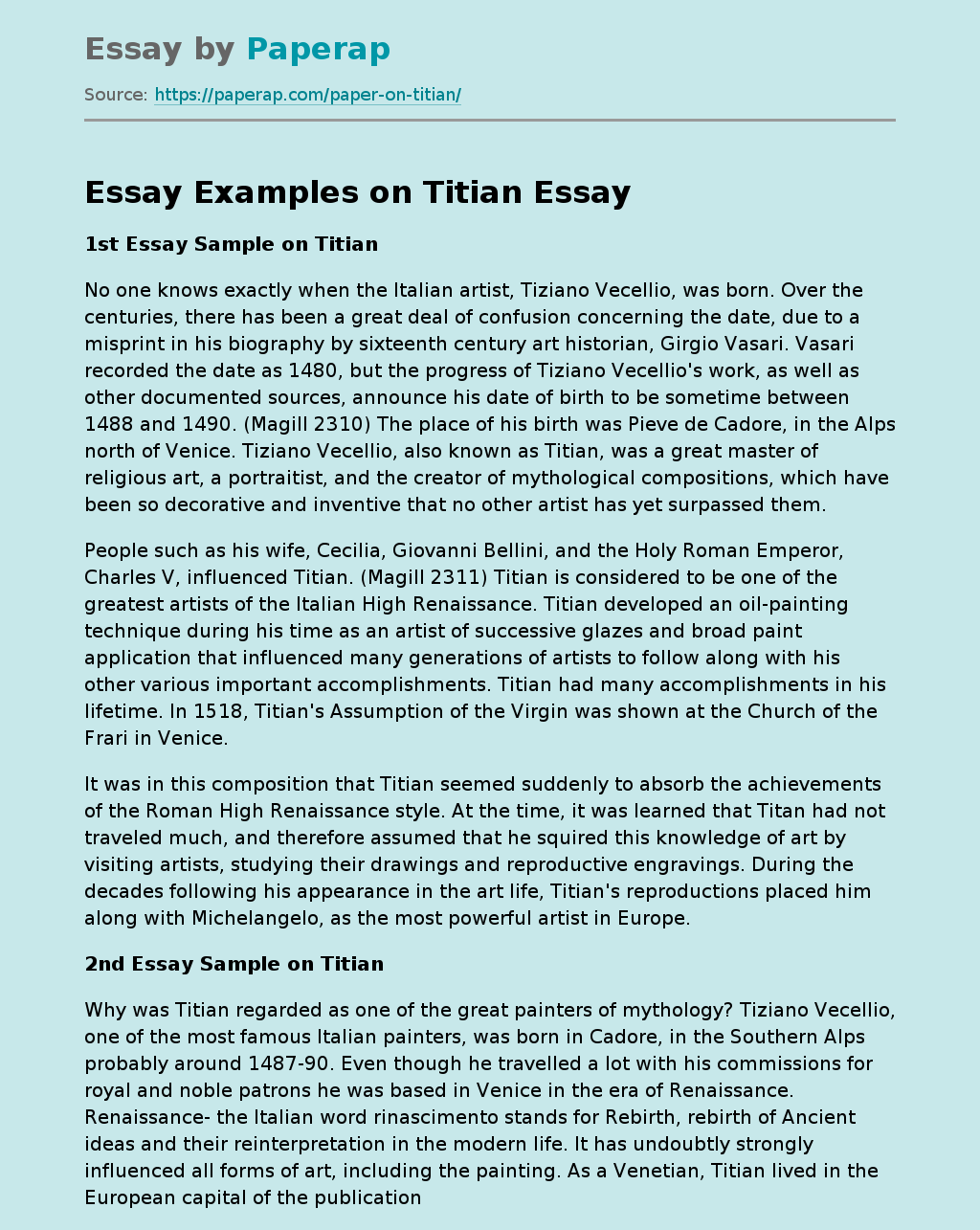Essay Examples on Titian
1st Essay Sample on Titian
No one knows exactly when the Italian artist, Tiziano Vecellio, was born. Over the centuries, there has been a great deal of confusion concerning the date, due to a misprint in his biography by sixteenth century art historian, Girgio Vasari. Vasari recorded the date as 1480, but the progress of Tiziano Vecellio’s work, as well as other documented sources, announce his date of birth to be sometime between 1488 and 1490. (Magill 2310) The place of his birth was Pieve de Cadore, in the Alps north of Venice.
Tiziano Vecellio, also known as Titian, was a great master of religious art, a portraitist, and the creator of mythological compositions, which have been so decorative and inventive that no other artist has yet surpassed them.
People such as his wife, Cecilia, Giovanni Bellini, and the Holy Roman Emperor, Charles V, influenced Titian. (Magill 2311) Titian is considered to be one of the greatest artists of the Italian High Renaissance. Titian developed an oil-painting technique during his time as an artist of successive glazes and broad paint application that influenced many generations of artists to follow along with his other various important accomplishments.
Titian had many accomplishments in his lifetime. In 1518, Titian’s Assumption of the Virgin was shown at the Church of the Frari in Venice.
It was in this composition that Titian seemed suddenly to absorb the achievements of the Roman High Renaissance style. At the time, it was learned that Titan had not traveled much, and therefore assumed that he squired this knowledge of art by visiting artists, studying their drawings and reproductive engravings.
During the decades following his appearance in the art life, Titian’s reproductions placed him along with Michelangelo, as the most powerful artist in Europe.
2nd Essay Sample on Titian
Why was Titian regarded as one of the great painters of mythology? Tiziano Vecellio, one of the most famous Italian painters, was born in Cadore, in the Southern Alps probably around 1487-90. Even though he travelled a lot with his commissions for royal and noble patrons he was based in Venice in the era of Renaissance. Renaissance- the Italian word rinascimento stands for Rebirth, rebirth of Ancient ideas and their reinterpretation in the modern life. It has undoubtly strongly influenced all forms of art, including the painting. As a Venetian, Titian lived in the European capital of the publication of classical studies and had an access to the mythology.
He was regularly surrounded by a circle of erudite friends, and was acquainted not only with a number of Ovid’s translations of the myths, but, more importantly, with their general philosophy. This deep knowledge of Ancient myths is, in my opinion, one of the reasons why he was regarded as one of the great mythological painters. In his paintings compared to analogical paintings by different artists one can see a story rather than a scene. For example if we look at the Titian’s “Diana and Actaeon”, one of the six paintings of his most famous group which he referred to as poesie, and compare it to Rembrandt’s “Diana surprised by Actaion”, we can clearly see a close up, people with emotions, thoughts, feelings through painted gestures and expressions. He portraits people as well as objects naturalistically.
There are a lot of details, which tell us a whole story, rather than describe just one scene of a myth.We can easily identify Diana, Actaeon and the nymphs. It is also possible to follow the story in time: three times and three fates of Actaeon within a single scene – him arriving to the goddess’s sacred grove, his transformation into the stag and his death and turning into the constellation Leo.
Essay Examples on Titian. (2019, Oct 10). Retrieved from https://paperap.com/paper-on-titian/

